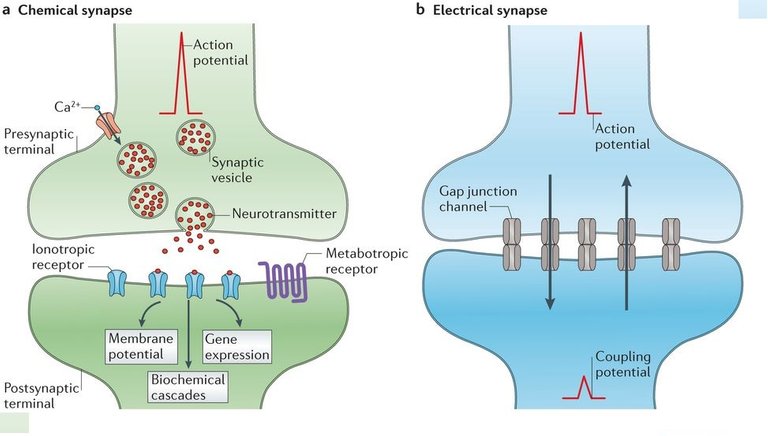you can find part 4 here https://steemit.com/health/@skytoin/basic-structure-of-the-nervous-system-4
If your neurons build the structure of your nervous system, then your synapses – the tiny communication links between them – are what make that structure into an actual system. Because, as great and powerful as your neurons are, when it comes down to it, their power and their purpose live in their connections. The synapse is basically a junctions or a crossroads.
Hopefully, you understand email and texting etiquette to know, that if you are going talk effectively, you suppose to respect the sanctity of the group list. It’s not a good idea to send a mass text to all of your friends first thing in the morning to give them the news that you just ate a really tasty cake. But if you are clubbing and unexpectedly someone famous shows up and starts singing karaoke then that would be appropriate time to notify all of your friends at once that something great is happening and they better be a part of it. Your nerve cells have two main modes for communicating with each other, depending on how fast the news has to travel. Some of your synapses are electrical – that would be like an immediate group text. Other are chemical synapses – they take longer time to be received and read, but they are used more often and are much simpler to control sending signals to only specific recipients.
The very swift electrical synapses send an ion current flowing directly from the cytoplasm of one nerve cell to another, through small windows called gap junctions. They are incredibly fast because the signal is never converted from its pure electrical state to any other kind of signal, contrarily to the chemical synapse. Instead one cell and one synapse can trigger thousands of theirs cells that can all act in synchrony. Something analogous happens in the muscle cells of the heart, where speed and team work between cells is essential. This seems like a good structure, so why do we need chemical synapses? It’s largely a matter of control, with such a direct connection between cells, an action potential in one neuron will create an action potential in the other cell across the synapse. That’s great in parts of the body like your heart, because you certainly don’t want a half a heartbeat. But if every synapse in your body triggered all of the neurons around it, your nervous system would basically always be in group text setting, with every muscle fiber and and bit of organ tissue always being stimulated and the replying all to the whole group which would stimulate them even more until everyone just got maxed out and drained and shot down their phones for good which means death. So that would be terrible, which is partly why we need chemical synapses. They are much more plentiful, but also slower, and they are more exact and discriminating in what messaged they send where.
Rather than raw electricity, these synapses use neurotransmitters or chemical signals, that diffuse across a synaptic gap to transmit their message. The key advantage chemical synapses have over electrical ones is that they can efficiently covert the signal in steps – from electrical to chemical back to electrical – which allows for several ways to control that impulse. At the synapse, that signal can be modified, amplified, inhibited, or split, either immediately or over longer periods of time. This set-up has two principal parts: The cell that’s sending the signal is the presynaptic neuron and it sends through a knoblike structure called the presynaptic terminal, usually the axon terminals. This terminal keeps an whole bunch of tiny synaptic vesicle sacs, each loaded with thousands of molecules of a given neurotransmitter. The receiving cell, meanwhile is thankfully the postsynaptic neuron and it receives the neurotransmitters in its receptor region, which is usually on the dendrite or just on the cell body itself. And these two neurons communicate even though they never actually touch. Instead, there’s a tiny gap called a synaptic cleft between them – less than five millionths of a centimeter apart. One thing to keep in mind is that messages that travel via chemical synapses are technically not transmitted directly between neurons, like they are in electrical synapses. Instead, there’s a whole chemical event that involves the release, diffusion, and reception of neurotransmitters in order to transmit signals.

Congratulations @skytoin! You have completed the following achievement on Steemit and have been rewarded with new badge(s) :
Click on the badge to view your Board of Honor.
If you no longer want to receive notifications, reply to this comment with the word
STOP